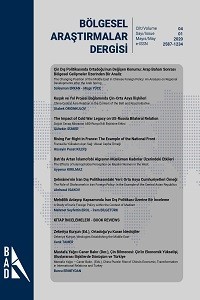The Impact of Ethnic, Religious, Geographic and Economic Factors on the Income Inequality in Iran
This study examines the effect of belonging to Persian and non-Persian ethnic groups, Shia and Sunni religious sects of Islam, living in border or non-border provinces and being oil and natural gas producer province on the income inequality in Iran. The results show there are a significant relation between ethnicity, religion and the location of provinces and inequality; regarding income per capita belonging to Persian ethnicity and Shia religion along with locating in the center of Iran are advantage while existence of oil and gas resources in a province do not bring about high income per capita. A comparative analysis of changes in income per capita of provinces or province groups with the oil revenues attests on low impact of oil incomes fluctuations on income inequality in Iran.
Anahtar Kelimeler:
Income Inequality, Iran, Ethnicity, Religion, Geography, Oil Revenues
___
- اسميت، آدام. ثروت ملل (جلد1)، ترجمه سيروس ابراهيم زاده، انتشارات پيام، تهران 1357
- مرکز آمار ایران، سالنامه آماری کشوری، تهران 1379-1392
- طرح بررسی و سنجش شاخص¬های فرهنگ عمومی کشور (1389-1392)، شورای فرهنگ عمومی کشور، تهران
- مارکس، کارل. نقدی بر اقتصاد سیاسی (جلد1-3)، ترجمه حسن مرتضوی، انتشارات آگه، تهران 1387
- AGHAJANIAN, Akbar, “Ethnic Ineqality in Iran: An Overview”, International Journal of Middle East Studies, Volume:15, No:2, 1983, pp.211–224
- AMANOLLAHI, Sekandar, “A Note on Ethnicity and Ethnic Groups in Iran”, Iran & the Caucasus, Volume: 9, No:1, 2005, pp.37–41
- BOEKTTE, Peter, Collapse of Development Planning, NYU Press, New York 1994
- BUYUKUSLU,Ali Rıza, “The Evolution of Privatisation in Turkey and its İmpact on Turkish Trade Unions”. Irish Journal of Management, Volume:16, No:1, 1995, pp.44-55
- GHARAMALEKI, Hossein Haghparast, “İran Türklerinin Ekonomik Gelişimleri (Doğu Azerbaycan İli Örneği)”, İran Türkolojisi Sempoziyomu, Ankara Üniversitesi, 2010
- GURIEW, Sergei – MEGGINSON, William, “Privatization: What have We Learned?”, Annual World Bank Conference on Development Economics, 2007, pp.249-96
- HESHMATI, Almas, “Inequalities and Their Measurement”, IZA Discussion Paper, No: 1219, Bonn 2004
- HIGGINS, Patricia J. , “Minority-State Relations in Contemporary Iran”, Iranian Studies, Volume: 17, No:1, 1984, pp. 37–71
- HILLMAN,Arye -URSPRUNG, Heinrich , “Political Culture and Economic Decline”, European Journal of Political Economy, Volume:16, No:2, 2000, pp.189-213
- KRUEGER, Anne, “The Political Economy of the Rent-Seeking Society”, The American Economic Review, Volume:64, No:3, 1974, pp.291-303
- KUZNETS, Simon, “Economic Growth and Income Inequality”, The American Economic Review, Volume:45, No:1, 1954, pp.1-28
- LEWIS, William Arthur, “Economic Development with Unlimited Supplies of Labour”, The Manchester School, Volume:22, No:2, 1954, pp.139–191
- SALEHI-ISFAHANI, Djavad, “Poverty, Inequality and Populist Politics in Iran”, Journal of Economic Inequality, Volume:7, No:1, 2009, pp. 5–28
- TULLOCK, Gordon, “The Welfare Costs of Tariffs, Monopolies, and Theft”, Economic Inquiry, Volume:5, No:3, 1967, pp.224-232
- WOLF, Kaitlyn R.-YOUNG, Andrew T. , “Globalization and income convergence”, No: 14-07, 2014, آدرس اینترنتی: http://business.wvu.edu/files/d/77b12b86-14f3-4284-b28d-a78f9d283916/14-07.pdf
- Yayın Aralığı: Yılda 2 Sayı
- Başlangıç: 2017
- Yayıncı: Mehmet Seyfettin EROL
Sayıdaki Diğer Makaleler
İran’ın Transnasyonel ve Teopolitik – Şiilik – Temelli Kamu Diplomasisi
The Future of Iran’s Influence in The Middle East
Murat GÖZTOKLUSU: Musul Özdemir Harekâtı ve Süleymaniye Kongresi
Mezhep ve Kimlik Bağlamında Ortadoğu’da İran’ın Güç ve Güvenlik Politikaları
D. Mehmet DOĞAN: Ortadoğu’nun Türkçesi
Suudi Arabistan-İran Rekabeti: Mezhep Görünümlü Çıkar Çatışması
2011 Sonrası İran’ın Irak Politikası
Realizm-İdealizm İkilemi Bağlamında İran’ın Dış Politika Yönelimlerine Teorik Bir Bakış
Iran’s Influence on The Future of The Regional Role of Iraq
The Impact of Ethnic, Religious, Geographic and Economic Factors on the Income Inequality in Iran
